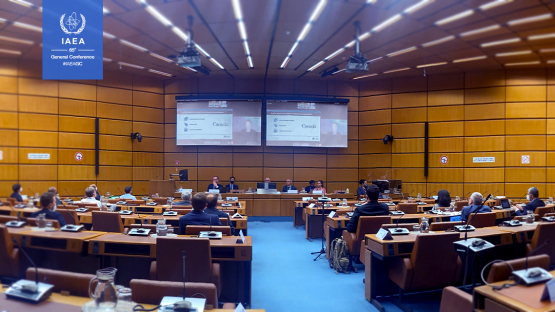The potential for nuclear power to produce low-carbon hydrogen in the global transition towards net zero emissions was examined by international experts, at an event on the sidelines of the 65th IAEA General Conference today.
The IAEA side event, Innovations in the Production and Use of Nuclear Hydrogen for a Clean Energy Transition, explored developments in the coupling of nuclear power reactors with hydrogen production plants to efficiently produce both electricity and hydrogen as a cogeneration system, as well as how energy sector cooperation, supply chain and policy support are facilitating the progress of these projects.
“A single 1 000 megawatt nuclear power reactor could produce more than 200 000 tonnes of hydrogen each year to fuel more than 400 000 fuel cell vehicles or more than 16 000 long haul fuel cell trucks,” Mikhail Chudakov, IAEA Deputy Director General and Head of the Department of Nuclear Energy, said in his opening remarks. “This is why nuclear hydrogen can be a game changer in the fight against climate change. Decarbonizing heavy industry, energy storage and even synthetic fuel production are some of the many roles it can assist us with in the clean energy transition.”
Hydrogen is the most abundant element in the universe but producing it in pure form for industrial processes – ranging from producing synthetic fuels and petrochemicals to manufacturing semiconductors and powering fuel cell electric vehicles – is energy intensive and currently with a significant carbon footprint. To reduce the environmental impact of the world’s annual production of over 70 million tonnes of hydrogen, several countries are looking to nuclear power.
Richard Boardman, Director for Energy and Environment Science and Technology Programs Office at the Idaho National Laboratory in the United States, presented the potential for leveraging today's light water reactors and tomorrow’s advanced reactors in producing affordable, clean hydrogen. “We are looking at putting small- to medium-sized reactors right within industry, where they can be dedicated to making hydrogen, which also takes away the cost of having to store and transport it,” said Boardman.
Nikolay Kodochigov, Advisor to the Director General of JSC Afrikantov OKBM, a nuclear engineering company located in Nizhny Novgorod in Russia, provided details on his country’s development of nuclear hydrogen production. This includes a project at the Kola Nuclear Power Plant in northwestern Russia, which involves construction of a pilot plant for testing electrolysers and gaining experience in hydrogen storage, transportation and application.
David Campbell, Director of Bruce Power Centre for Next Generation Nuclear at the Nuclear Innovation Institute in Canada, described an ongoing project that is looking into producing nuclear hydrogen to capitalise on Ontario’s existing clean power grid and its baseload surplus. “The centre’s study is exploring the technical feasibility for hydrogen production and the business case for a local hydrogen market,” he said, adding that the results of the study will be published in the coming weeks.
Kees Jan Steenhoek, Director of Government Affairs at UK nuclear fuel company URENCO, presented the preliminary conclusions of a study commissioned by URENCO that examined the potential role of nuclear-produced hydrogen in helping to decarbonize the UK economy by 2050.
According to the results of the study, it is possible to create a low-carbon energy system coupling nuclear power with renewables and hydrogen. “If you increase the percentage of nuclear power in the mix, the overall system gets cheaper,” Steenhoek said. Advanced reactors capable of producing hydrogen with high-temperature heat can bring even greater efficiencies to the process and play a big role, added Felix Chow-Kambitsch of Aurora Energy Research, which carried out the study.
The conclusions of a separate study recently conducted by the IAEA, using the Agency’s FRAMES modelling system, were broadly consistent with Aurora’s results, said Francesco Ganda, an IAEA nuclear engineer. And in a scenario where future low-carbon hydrogen production is unable to rely on fossil facilities equipped with carbon capture and storage, advanced nuclear power reactors can play an even bigger role, he said.








